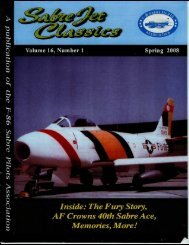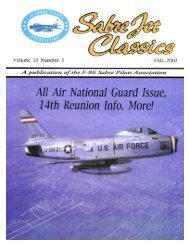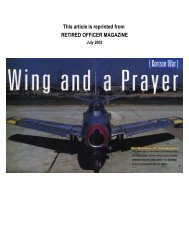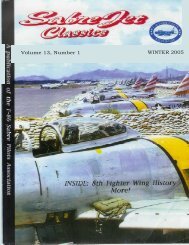Volume 8 Number 1 Spring 2000 - Sabre Pilots Association
Volume 8 Number 1 Spring 2000 - Sabre Pilots Association
Volume 8 Number 1 Spring 2000 - Sabre Pilots Association
Create successful ePaper yourself
Turn your PDF publications into a flip-book with our unique Google optimized e-Paper software.
Memories Of Great Fighter <strong>Pilots</strong><br />
-This Issue:<br />
Frederick C. "Boots" Blesse<br />
by Earl Brown<br />
As with most great men and women in history, stories abound which<br />
shed light on the source of their greatness. With this in mind, <strong>Sabre</strong> Jet<br />
Classics presents the second in a series of anecdotes received from you,<br />
the members. Lt.Gen. William E. 'Earl' Brown, USAF (Ret), of Alexandria,<br />
Virginia, sent us the following story. We invite other members to send<br />
their memories of the great ones they have known.<br />
I was a 24 year old 2nd Lt. when I met Captain 'Boots '<br />
Blesse. We were in the 334th Fighter Interceptor<br />
Squadron, 4th Fighter Wing, based at K-14 (Kimpo),<br />
South Korea; and we were flying F-86 <strong>Sabre</strong>s into North<br />
Korea looking for Soviet MiGs. 'Boots' was clearly the<br />
best pilot in our squadron and probably the best in<br />
the 4th Wing at the time. Not only could he fly and<br />
fight in the <strong>Sabre</strong>, he could tell others how to do it.<br />
He was also the natural leader of the squadron. I had<br />
the impression that if we were all on a desert island,<br />
with no visable signs of military rank, `Boots' would've<br />
still been the leader. He used to say that "Rank is your<br />
ace in the hole. Don ' t use it until it is necessary! " He<br />
led by example. He was a ferocious competitor. In every<br />
game he played, he refused to lose. An exceptional<br />
fighter pilot needs the same skills and attitude as a<br />
superb athlete.<br />
First start with DESIRE TO BE IN THE GAME. Many people<br />
train to be fighter pilots, but not all will fly to the `sound<br />
of the guns'. `Boots' was always listening for the 'sound<br />
of the guns', and would go uncommanded to that sound.<br />
Like Michael Jordan, when the game was on the line,<br />
he wanted the ball.<br />
Second, hand-eye coordination and physical strength<br />
and stamina are absolute requirements. I try to tell my<br />
civilian friends that there can never be old men flying<br />
actively as fighter pilots. The physical demands are too<br />
great. Strap on the oxygen mask for an hour and a half,<br />
maneuver to pull Gs that magnify your body weight by<br />
4, 5, or 6 times, maintain your awareness of the<br />
situation around you in three demensions, anticipate<br />
your enemy ' s moves, plan your own moves, fly the<br />
airplane within its prescribed limits of airspeed,<br />
altitude, engine temperature - and do these things<br />
continuously during the flight. 'Boots' did all these<br />
things all the time, and did them exceedingly well.<br />
Third, calculate and think about the tactics of the<br />
engagement between two fighter aircraft. Scheme about<br />
ways to maximize your aircraft's advantages, and zero<br />
in on the opponents weaknesses. 'Boots' had thought<br />
about the problems of air-to-air combat for many years.<br />
He had trained and practiced and honed and polished<br />
tactics over and over during those years.<br />
I have been told that he has been an excellent golfer<br />
for many years. The skills he learned in observing the<br />
effects of tiny changes in the angle of the club head<br />
18<br />
Major Frederick "Boots " Blesse, sits in the cokpit of his<br />
F-86E on the ramp at K-14, Kimpo AB, South Korea, in<br />
September 1952. His <strong>Sabre</strong> shows 5 MiG kills, and 3 damaged.<br />
Blesse made 'ace' on 4 September 1952. (credit -<br />
Larry Davis collection)<br />
and velocity of the swing, translated almost directly<br />
into the sensitive handling of the <strong>Sabre</strong> at the limits of<br />
its flying envelope, when the aircraft is very close to<br />
stall at high altitude. Or when you are turning as hard<br />
as you can at maximum speed at low altitude.<br />
Most fighter pilots could fly the <strong>Sabre</strong> well in the heart<br />
of the envelope defined by maximum and minimum<br />
speeds and altitudes. Only a few could get top<br />
performance from the airplane while flying at or near<br />
the limits of the airplane's design. 'Boots' delighted in<br />
taking young pilots up and showing them how to fly at<br />
the edges of the airplanes capabilities.<br />
There was one mission when he shot down a North<br />
Korean YAK-9, a Soviet propeller-driven fighter that<br />
looked like a cross between a P-47 and a FW-190. Col.<br />
Royal Baker, 4th Group Commander, had engaged two<br />
Yaks and was attacking them. As he closed to firing<br />
range, the YAKs would pull into a tight turn and evade<br />
his bullets. 'Boots' heard the melee on the radio and<br />
we flew to the fight location, i.e. "to the sound of the<br />
guns."Boots' set up an orbit high above the fracas and<br />
watched Col. Baker make two or three passes on the<br />
YAKs. Each time the YAK pilots would simply out-turn<br />
him as he reached firing range.<br />
Finally, 'Boots' asked if he could make a pass.<br />
Frustrated, Col. Baker reluctantly approved. 'Boots'<br />
started down in a classic high-side approach, just as<br />
though he were setting up on a towed target. As he slid<br />
into range, the YAK, almost casually, racked into a hard<br />
turn, surely thinking - "Another dumb American!" Was<br />
he surprised when, instead of over-shooting and<br />
zooming up for a re-attack as Col. Baker had done,<br />
`Boots' simply popped the speed brakes on his <strong>Sabre</strong><br />
and slowed to just a mite faster than the YAK! He<br />
continued to close and could now match the turning<br />
capability of the propeller plane, while hosing the YAK<br />
fuselage with bullets. The YAK went down.<br />
This maneuver is one 'Boots' had used in training<br />
against P-51s, and he knew from experience that it<br />
would work.









